Time-lapse flowering of my whale’s tongue agave
My beloved whale’s tongue agave (Agave ovatifolia) bloomed this year, as regular readers know. I long ago dubbed it Moby, and I’ve watched it grow in two of my gardens for 11 years. I even threw Moby a 10th birthday party last year, complete with tequila cocktails, which I admit had a hint of cannibalism, at least from Moby’s point of view.
Ten years is a pretty long life for an agave in a pampered garden setting, so I wasn’t surprised to see a phallic bloom stalk erupt from the center of the plant in early April.
It branched into a candelabra as it nestled into the live oak canopy above. By early May, flower buds were swelling at the ends of the branched stems.
By late May, heavy clusters of golden flowers opened, to the excitement of neighborhood pollinators.
By late June, the flowers were spent, and hundreds of messy seedpods carpeted the ground around the agave and littered its broad, cupped leaves.
And then, long after I expected Moby to collapse in a heap of wilted leaves (agaves bloom only once and then die), Moby did something surprising: he refused to die. To my surprise, he still looked pretty good — for months after flowering. What was he waiting for, I wondered.
But suddenly I’m seeing something new: bulbils — i.e., tiny clones of the mother plant!
Clustered in tight balls at the ends of the upper tiers of the bloom stalk, the bulbils even seem to be blooming. How strange! I’m excited to see Moby reproducing in this way, especially as I didn’t find any seeds in the half-dozen fallen seedpods I opened.
In nature, the bloom spike would eventually topple over, and some of the bulbils would take root and grow, replacing the dead mother plant. Considering the size of the stalk — at least 15 feet — I’m hoping to forestall any toppling and will cut it down pretty soon. But I want to give those bulbils a little more time to mature.
I’ve never watched a whale’s tongue agave bloom, and it’s been a fascinating process.
I welcome your comments; please scroll to the end of this post to leave one. If you’re reading this in a subscription email, click here to visit Digging and find the comment box at the end of each post.
_______________________
Digging Deeper: News and Upcoming Events
South Texans, come see me at the 2nd annual Planta Nativa festival in McAllen, Texas, on Saturday, October 22. I’ll be delivering the keynote talk, “Local Heroes: Designing with Native Plants for Water-Saving Gardens,” that evening. Tickets go on sale soon at Quinta Mazatlan. I hope to see you there!

All material © 2006-2016 by Pam Penick for Digging. Unauthorized reproduction prohibited.


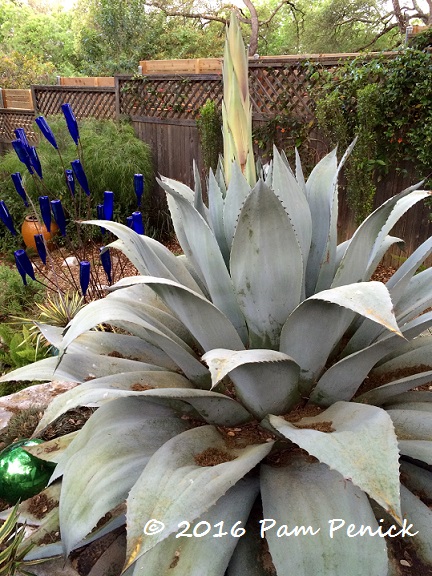
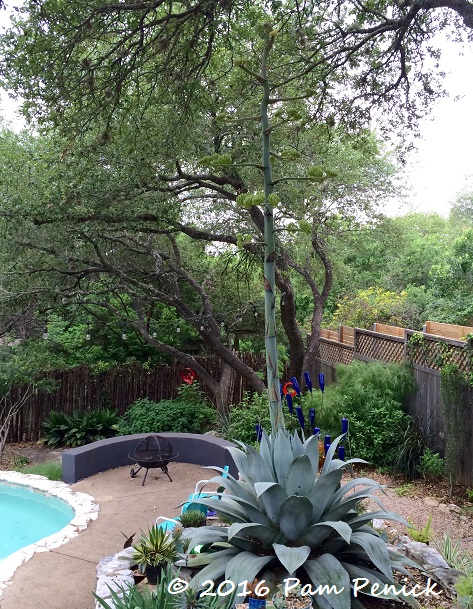
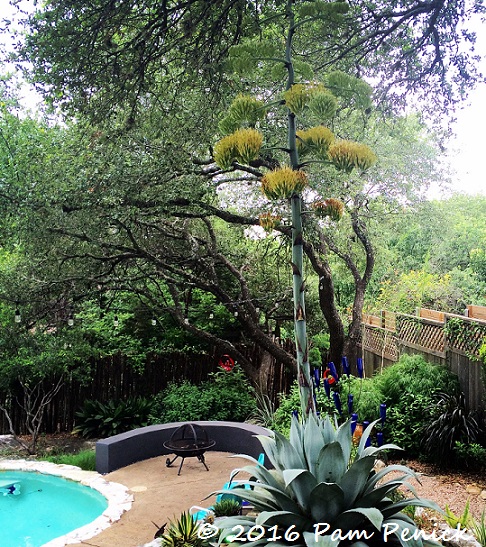
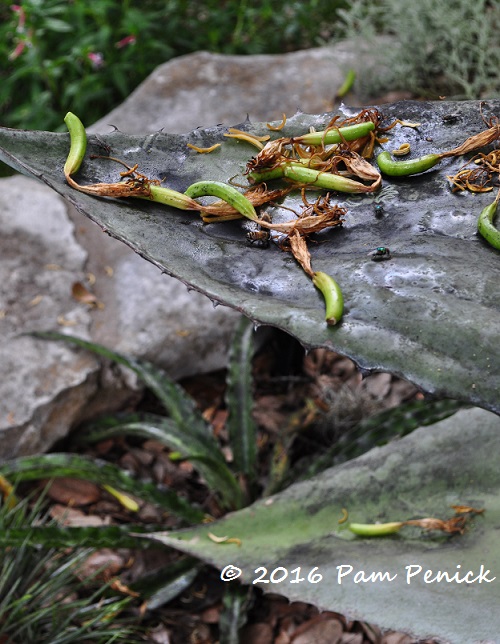
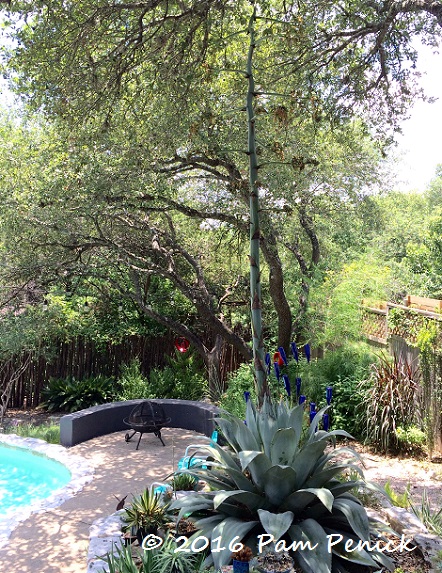
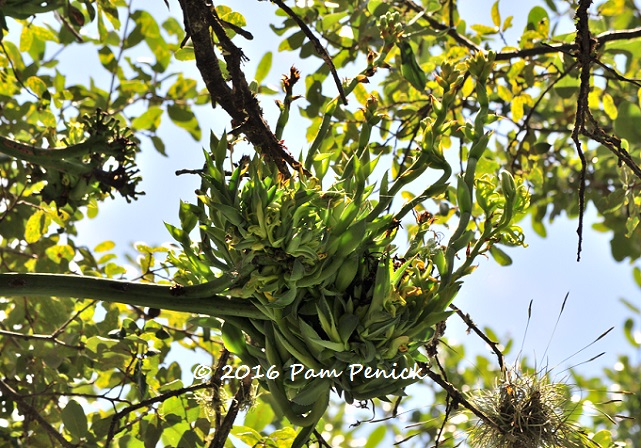
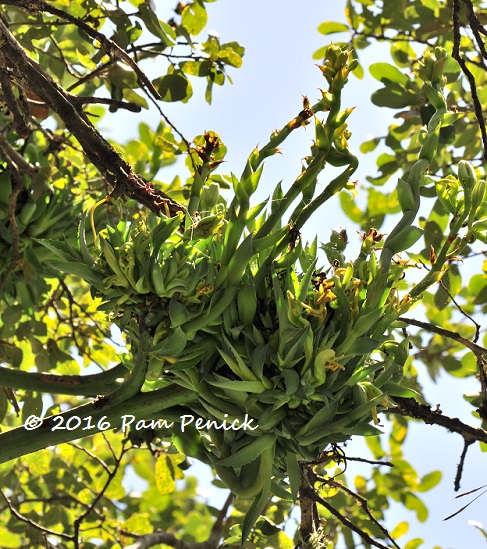

That really is a great time lapse presentation, Pam. I need to learn how to do that. It was hard for me to tell what I was seeing in the photo about bulbils. I’m used to bulbils looking like blueberries, not hydra hair.
I figured out how to turn the pictures into a time-lapse video in about 10 minutes, Peter. I used Movie Maker for the PC. I alternate between a PC and a Mac; it’s probably even easier on a Mac.
I’m not familiar with blueberry-shaped bulbils, though! —Pam
Nicely done with the video! Thanks for sharing the progress during the past few months–fascinating stuff! I hope you’ll continue to keep us posted.
I’ll be sure to document the rest, Beth. Thanks for following along! —Pam
I hope you get lots of mini-Mobys, Pam. If they all make it, you’re going to have a real challenge with the naming process.
Haha! Yes, that would be a challenge. —Pam
Leave it to Moby to finally decide to go out in a very dramatic way. Bulbils and flowering bulbils all in a big congested nest…I am impressed. Hope there will be lots of little Mobys to give away and spread the love.
Oh, I feel sure there will be, Loree. 😉 —Pam
I was wondering how Moby was doing. Thanks for the post.
Moby says hi, Jeanne. —Pam
I am glad that you are talking about Moby. I was with some garden bloggers this past weekend and someone asked me if I knew if Moby had died yet. He/she is making sure you have some little Mobys to remember him/her by.
People are asking about Moby? Aww! Yep, he’s still kicking…for now. —Pam
No need to leave the bulbils too long–they root better before they get too dried out on the stalk. Soon you will have “Moby Junior” to enjoy.
Thank you for the tip, Hoov! It’s coming down this weekend then. —Pam
if he would keep his um, stalk, up for a few more months it would look very cool with lights on it.
That would look cool, but I need to get his replacement planted before it gets cold and wet this winter. —Pam
You have had a summer of entertainment from the supreme Moby. He is still quite handsome even in his days of decline. I wish I had met him. At least I got to meet him in the virtual world.
I hope you’ll meet one of his offspring one day, Layanee. —Pam
How cool, to watch the progress.
He has hung in there a long time.
Yes, he has. —Pam
What a show and a hard act to follow for your new A. ovatifolia. I hope you were hiding his/her eyes. Let us know when the bulbils are available and I will drop by with the Philippine violet. I have it potted up and ready for you.
I’ll be sure to save you a handful, Jenny! —Pam
When my favorite agave died I could not part with the flower stalk so I lashed it to a dead tree trunk in my back yard. The hummingbirds have claimed it as a lookout post for the last four years. It has been fun to watch them protecting the vast backyard.
What a good re-use that keeps its memory alive. —Pam
mmm the dead flower stalk would make an architectural statement
Yes, it’s quite something. —Pam